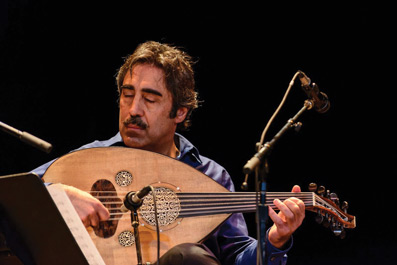Simon Shaheen’s Musical Fusion
Oud/Violin Virtuoso Plays Campbell Hall

Internationally acclaimed for his virtuosic oud and violin playing, Simon Shaheen also has the unique ability to fuse music of different cultures into something remarkably authentic. Born in Palestine, Shaheen was playing both the oud and the violin by the age of 6. He immigrated to the United States in 1980 to pursue higher education, studying music at both the Manhattan School of Music and Columbia University and along the way establishing the Near Eastern Music Ensemble and Qantara, groups that both combine various global styles and traditions. The latter’s album, Blue Flame, garnered 11 Grammy nominations. When Shaheen is not performing as a soloist or with his ensembles, he teaches at the Berklee College of Music. In a recent phone conversation with the Independent, Shaheen shared his views on instruction and the nature of fusion music ahead of his upcoming Santa Barbara performance on Wednesday, November 15.
How has this year been for you as an artist? Couldn’t be better. Every year is a continued process of creativity, projects, touring, and teaching, so it’s an endless process.
Can you describe your creative process when you are composing? There are certain elements I have to consider when it comes to composing. I have to make a choice of the style and the genre. For example, if I want to do traditional Egyptian composition, or Palestinian, I have to consider the style and tradition itself …. Now I also compose Western classical music. I also do world fusion, where I bring various musical cultures into one concept of creativity. Organically, it works together very well. It’s like what I did in one of my recordings, Blue Flame. This is the concept of fusing two cultures together. In order to do this, it’s clear to me that without knowing the various cultures, it’s impossible to fuse them together.
If you hadn’t chosen music, what profession would you see for yourself? When I graduated from high school back in Palestine, I was very successful in sciences. I was entertaining the idea [of pursuing them]. I lived for a time in a period of conflict where I had to decide, “Do I go to law school, medical school?” It took three to four months. Very tough. I asked myself a simple question: How many people can be good and successful musicians, and how many can be good and successful lawyers? I found that not many can make music, which is very creative, but many people can do law.
What led you to form your musical ensemble Qantara? When I arrived in the United States, I went to the Manhattan School of Music and Columbia University for graduate studies. At the same time, I looked around and saw no presentation of Middle Eastern or Arab music at large. So I decided to establish a musical ensemble. Luckily, there were some fantastic musicians from the Middle East who lived in New York and Chicago, and Detroit and Boston, so I thought I would contact those musicians, and little by little they all moved to New York. I connected with the performing arts centers in the U.S., and we started to perform there and at colleges, and at the same time I was offering workshops. This led to creating Qantara, this idea that I explained before of musical cultures meeting in one ensemble. I started to compose music based on this concept, and it was very successful. It led to our only one recording based on this fusion of music that was nominated for 11 Grammys. It became a cornerstone in defining fusion purely because of its authenticity. It was a very nourishing process.
Can you describe the oud in just a few words? It’s plucked. It’s the forerunner of the lute and guitar family. It has double strings; I believe [it] has better projection than the acoustic guitar. It has an open fingerboard, allowing [one] to perform microtonal music, which is a feature in Middle Eastern music. Microtonalities are the essence of this music. Very round sound.
You have a busy career performing as a soloist and with different musical ensembles, as well as teaching. Why is the study of music important? I teach at Berklee College of Music in Boston, which started as a college that concentrated on jazz music. Why is it important to learn music in school? School offers a rounded program that covers several areas, not only music performance, and all the theories and composition. Students can bring their talent and personality into the school and the creative process. Berklee itself has almost 5,000 students who only learn music, and not only music as performance and theory, but other aspects, such as music therapy, music engineering, music marketing, and film scoring. It’s a very elaborate musical [education] system. I believe this will enhance the student’s experience.
4·1·1
Simon Shaheen and his ensemble perform Wednesday, November 15, 8 p.m., at Campbell Hall, UCSB. Call 893-3535 or visit artsandlectures.ucsb.edu.



